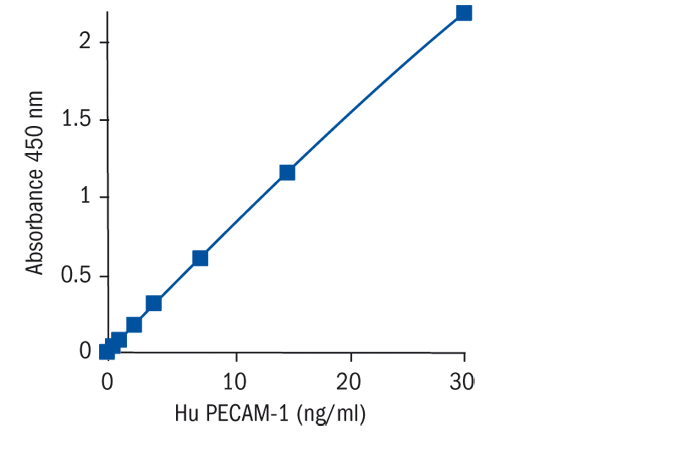Type
Sandwich ELISA, HRP-labelled antibody
Applications
Serum, Urine, Plasma, Cell culture supernatant
Sample Requirements
10 µl/well
Shipping
At ambient temperature. Upon receipt, store the product at the temperature recommended below.
Storage/Expiration
Store the complete kit at 2–8°C. Under these conditions, the kit is stable until the expiration date (see label on the box).
Calibration Curve
Calibration Range
0.48–30 ng/ml
Limit of Detection
0.06 ng/ml
Intra-assay (Within-Run)
CV = 1.7%
Inter-assay (Run-to-Run)
CV = 7.4%
Spiking Recovery
108,00%
Dilution Linearity
91,40%
Research topic
Cell adhesion proteins, Oncology
Summary
PECAM-1 (platelet endothelial cell adhesion molecule-1) also called CD31 and EndoCAM is a newly characterized adhesion molecule that belongs to the immunoglobulin superfamily [14]. PECAM-1 is a transmembrane glycoprotein with a molecular weight of approximately 130 kDa, depending on the degree of glycosylation.
PECAM-1 is constitutively expressed on all vascular cells and has provided a useful immunohistochemical marker of blood vessels, particularly in the setting of angiogenesis. It has also been found on platelets, monocytes, neutrophils and CD8+ T cells. Bone marrow stem cells and transformed cell lines of the myeloid and megakaryocytic lineage also express PECAM-1. Interestingly, PECAM-1 was also detected on human, mouse and rat solid tumor lines .
Recent studies suggest a role for PECAM-1 in the inflammatory process and leukocyte-endothelial interaction. The process of leukocyte emigration to the site of inflammation can be dissected into three successive stages: rolling, mediated by the selectins; tight adhesion mediated by ICAMs and their counter-receptors, the integrins; and transmigration of leukocytes through intercellular junctions of vascular endothelial cells which requires PECAM-1. PECAM-1 appears to be able to interact both with itself (homophilic binding) and with other "non-PECAM-1" molecules (heterophilic binding).
PECAM-1 is an early and sensitive marker for tumor-induced angiogenesis. Several data have suggested that PECAM-1 may be involved in the process of angiogenesis in a developing vertebrate embryo as well as during metastases formation.
Besides the membrane-bound form of PECAM-1 a soluble form of the molecule exists, which is 5-10 kDa smaller than cell-associated PECAM-1, and contains the cytoplasmic tail. This form of soluble PECAM-1 is encoded by an alternatively spliced mRNA from which the exon containing the transmembrane domain has been removed. Soluble PECAM-1 was detected in normal human plasma. Antibodies against PECAM-1 have been shown to exhibit a high degree of sensitivity and specificity for endothelial cells in normal, inflammatory and neoplastic tissue. PECAM-1 is a sensitive and specific marker for detection of melanoma-associated angiogenesis. Thus, PECAM-1 may be a useful marker for early detection of tumor metastasis. Compared to normal gut, there is a significant increase of PECAM-1-positive vessels in the mucosa of uninvolved ulcerative colitis. In gingivitis and periodontitis lesion the expression of PECAM-1 on mononuclear infiltrates increases significantly with increasing size of infiltrate.
Find documents for the lot
Example Instructions for Use (RUO)
Example Instructions for Use (RUO)
Safety Information (RUO)
MSDS (RUO)

